Fact Sheet FS1354
The American cranberry (Vaccinium macrocarpon Aiton) holds a rich historical significance as a North American crop. Leading cranberry-producing regions such as New Jersey grapple with insect pests, necessitating the implementation of integrated pest management (IPM) strategies to achieve both economic viability and sustainable control. IPM programs for cranberries incorporate many tactics to deal with insect pests, notably biological and natural control, chemical control, cultural control, behavioral control, and host-plant resistance. Before a successful IPM program can be implemented, growers need to first be able to identify and monitor the pests and recognize their damage in the cranberry bogs (also known as beds or marshes). This will allow growers to make informed decisions on management practices that will be the most economically and ecologically efficient.
Monitoring
There are many methods to scout for insect pests in cranberries (Figures 1 and 2). One of the most common scouting tools is the use of a 12-inch diameter sweep net (Figure 1). This net is swung in a 180° arc along the canopy 25 times, which is considered one sweep set. Each acreage size requires a different number of weekly sweep sets for proper monitoring, with a general recommended number of one sweep set per acre. Depending on the number of insects caught in the sweep set, growers can determine whether a pest has reached its action threshold, which is defined as the point at which it is advised to control the pest before the management costs outweigh the yield profits. Other ways growers can monitor insects is by use of pheromone-baited traps (Figure 1). Sex pheromones of many insect pests of cranberries are commercially available to allow growers to measure their relative quantities in a certain area. Sweep net sampling is commonly used to monitor pests early in the growing season, i.e., before bloom, while pheromone traps are placed during bloom to monitor mainly lepidopteran pests (Figure 2).
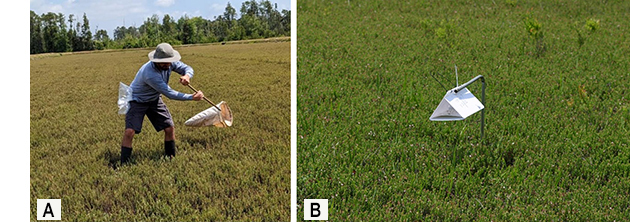
Figure 1. Monitoring insect pests of cranberries using sweep net (A) and pheromone-baited traps (B).
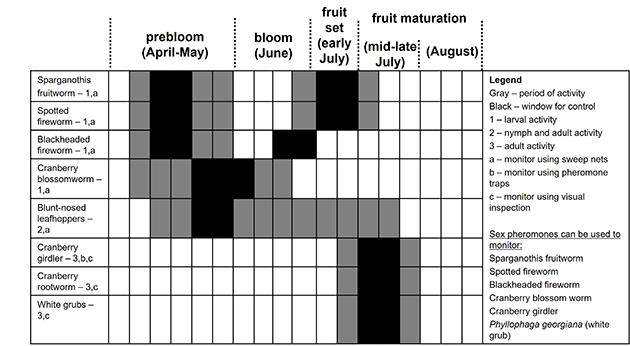
Figure 2. Activity periods of cranberry insect pests in New Jersey. Bars show the period when scouting (in gray) and management (in black) of the pest is most important.
Description, Damage, Sampling, and Control
Sparganothis Fruitworm
Sparganothis sulfureana Clemens (Lepidoptera: Tortricidae)
Threshold: 1.5 larvae per 25 sweeps
Description
Sparganothis fruitworm is an important direct pest to cranberries in New Jersey. The first instars have a black head capsule that gets browner and lighter in later instars. The body of the larvae tends to be green with pale spots, with the underside being paler (Figure 3). There have been cases in which the larvae are yellowish or creamy in color. First instar larvae are around 1.5 mm (0.06 inch) long, and the full-grown larvae are 14.5 mm (0.6 inch) long as males and 16.5 mm (0.65 inch) long as females. Larvae enclose themselves inside leaves with their silk webbing and remain there until pupation. Pupae are dark brown and are around 8.75 mm (0.35 inch) long, and last for 7–12 days. The adults have yellow wings that, when folded, appear to have an X-shaped marking across the wings (Figure 3) and have an average forewing length of 7 mm (0.3 inch). They have two generations a year, with adults emerging in early June and then again in mid-August to September. Adult females lay egg masses with 20–50 eggs on the upper side of cranberry leaves or fruit, or weeds, which take 9–12 days to hatch. Early instars of the second generation go into hibernation by mid- to late-September.
Damage
The first-generation of Sparganothis fruitworm larvae feed mostly on the foliage and occasionally on blossoms that they have webbed together. The second-generation larvae are the most damaging because they can attack developing fruit in addition to the foliage. The larvae make a feeding hole and then enter the berry to eat the seeds, which turns the unripe berries red.
Sampling and Control
Pheromone traps placed every 10 acres and checked weekly are the most common method for monitoring adult flight and population size, which normally peaks towards the end of June. To monitor larvae, the action threshold is an average of 1.5 larvae per 25 sweeps. The first-generation larvae are often controlled by natural enemies, so a pre-bloom insecticidal spray is not normally recommended, as it can kill the natural enemies as well. If populations exceed threshold levels, then growers can use reduced-risk insecticides, such as insect growth regulators (IGRs), to manage this insect. The timing for the first post-pollination spray is 2 weeks after peak pheromone trap catches. Certain biological control agents have shown efficacy against this pest, such as entomopathogenic nematodes (Oscheius onirici) and the bacteria-based biopesticide Venerate (Burkholderia spp. Strain A396).
Figure 3. Sparganothis fruitworm adult and larva (Photo credit: Dan Schiffhauer).
Spotted Fireworm
Choristoneura parallela Robinson (Lepidoptera: Tortricidae)
Threshold: 4 larvae per 25 sweeps
Description
Spotted fireworm is one of the most important direct pests of cranberries in New Jersey. It becomes a problem in weedy bogs because female moths lay their eggs predominantly on weeds, such as yellow loosestrife, red root, red maple, and greenbrier. It has two generations a year. The larvae overwinter on the bog floor and continue to develop in April-May. Adults appear in early-June. Eggs from the first generation are laid late in June; larvae from the second generation will complete development and emerge as adult moths in early August and lay eggs. Eggs from the second generation hatch in mid-August. The early-instar larvae have brown head capsules with whitish bodies, but older instars have a lighter brown head capsule and a green body that has noticeable white spots along the length, each of which has a hair (Figure 4). The larvae can reach 19 mm (0.75 inch) in length while the pupae are 13 mm (0.5 inch). Adults are brown with two diagonal dark stripes on each wing and have a wingspan of 19 mm (0.75 inch) (Figure 4).
Damage
First-generation spotted fireworm larvae web foliage together to eat and, as they grow, increase the number of cranberry uprights in their web. Because this insect overwinters as a larva, they can begin causing damage as soon as it gets warm enough, normally around April to May. Second-generation larvae are active in July and can feed both on foliage and fruit. Like Sparganothis fruitworm, the larvae tunnel into the berry.
Sampling and Control
The action threshold for spotted fireworm is 4 larvae per 25 sweeps. Adults can also be monitored using sex pheromone lures. Because females lay their eggs on plants other than cranberries, keeping bogs clean from weeds will keep this insect under control. Also, many natural enemies such as Trichogramma wasps can regulate spotted fireworm populations. If the populations reach the threshold, reduced-risk insecticides such as IGRs can be used.

Figure 4. Spotted fireworm adult and larva (Photo credit: Elvira de Lange).
Blackheaded Fireworm
Rhopobota naevana Hübner (Lepidoptera: Tortricidae)
Threshold: 1.5 larvae per 25 sweeps
Description
Blackheaded fireworm is a direct pest of cranberries. The eggs overwinter on the bog and usually hatch by mid-May. The larvae have black head capsules, with their bodies ranging from green to gray (Figure 5). The oldest instars reach around 10.5 mm (0.4 inch) in length, while the pupae are slightly smaller at around 6.5 mm (0.25 inch) and are tan in color. The adult wingspan is around 10.5 mm (0.4 inch), and they have gray and brown wings (Figure 5). This insect has two generations per year, with the first-generation adults emerging in late May to mid-June and the second-generation adults emerging in mid-July to August. Adult females lay their eggs on the tips of new cranberry growth.
Damage
The first-generation larvae become active in early May, feeding on the foliage that they have webbed together, skeletonizing the leaves, which can cause vines to appear as if burned. The second-generation larvae are active in late June and are more destructive, feeding on foliage and fruit; however, unlike Sparganothis fruitworm, they eat at the surface of the fruit and do not tunnel. The larvae can thus directly reduce yield by fruit feeding but can also reduce future yields by the damage inflicted on the vines.Sampling and Control
Monitoring for first-generation larvae is accomplished using sweep nets, with an action threshold of an average of 1.5 larvae per 25 sweeps and should be done more so on the edges of the bogs where the vines first start growing. Pheromone traps can also be utilized to sample adult male populations, with one trap placed every 10 acres and checked weekly. It is much easier to control this pest if larvae are detected prior to bloom. Reduced-risk insecticides such as IGRs can be used successfully to control the larvae when the threshold is met. Trichogramma parasitoid wasps can also be utilized to control this pest.
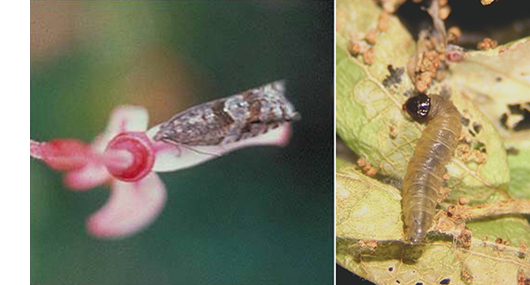
Figure 5. Blackheaded fireworm adult and larva (Photo credit: Dan Schiffhauer).
Cranberry Blossomworm
Epiglaea apiata Grote (Lepidoptera: Noctuidae)
Threshold: 4.5 larvae per 25 sweeps
Description
This insect has one generation, with eggs laid in October on fallen leaves and pieces of dead vine littering the ground. These eggs overwinter and begin to hatch in late April to early May. Young larvae are green but older larvae become reddish brown with a white stripe along each side of the body. There are six larval instars. Mature larvae become pale brown and nearly 38 mm (1.5 inch) long (Figure 6). Larvae become nocturnal by mid to late May. Pupation takes place in the ground or deep trash in late July and early August. Adult moths start to emerge in September and are active until late November. Adults can range from light brown to dark brown (Figure 6) and have two darker rings in between two darker stripes on both forewings, and their wingspan can reach 34 mm (1.3 inch).
Damage
Early-instar larvae nibble the leaves or bore into the buds. Fruit production is further decreased as older larvae nip off buds and blossoms, dropping them to the ground often cutting off more blossoms than they can consume. Each mature worm can fully destroy 100 blossoms over a three-week period, which occurs from May to June.
Sampling and Control
Due to the nocturnal behavior of the older instars, sweep net sampling should take place at night between 9 p.m. to 1 a.m. The threshold for cranberry blossomworm is an average of 4.5 larvae per 25 sweeps. Like the other lepidopteran pests, reduced-risk insecticides such as IGRs provide effective control.
Figure 6. Cranberry blossomworm adult and larva (Photo credit: Elvira de Lange).
Blunt-nosed Leafhopper
Limotettix vaccini Van Duzee (Hemiptera: Cicadellidae)
No known threshold
Description
Blunt-nosed leafhoppers are one of the most important pests of cranberries in New Jersey because they transmit a phytoplasma that causes false blossom disease. Eggs begin to hatch in early May, and the nymphs (Figure 7) go through five instars in about a month. The adults begin to appear by the end of June, are most abundant in mid-July, and their numbers start to diminish by the first week in August. The adults have a characteristic blunt head and vary from light yellowish gray to dark brown (Figure 7). Nymphs start at 1.5 mm (0.06 inch) in length and adults reach 4 mm (0.15 inch) in length.
Damage
Both nymphs and adults are piercing-sucking insects that feed on the plant’s phloem. While the physical injury from the feeding is not noticeable, these insects vector a phytoplasma that causes false blossom disease. This disease prevents the infected plant from producing fertile flowers, therefore decreasing berry production and overall yield.
Sampling and Control
There is no current action threshold for this pest. To monitor the nymphs, it is recommended to use sweep nets before bloom. The most effective control method is the use of a broad-spectrum insecticide (pyrethroids, organophosphates, or carbamates) before bloom. Broad-spectrum insecticides need to be used carefully since they can pose a threat to beneficial insects like the natural enemies of insect pests.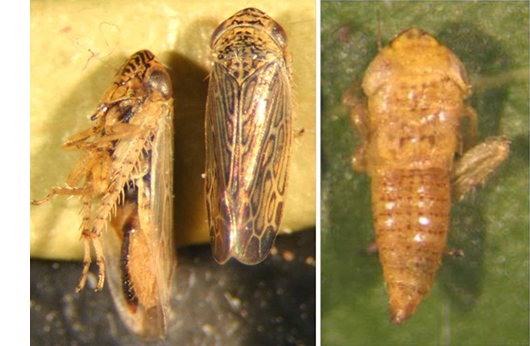
Figure 7. Blunt-nosed leafhopper adult and nymph (Photo credit: Dan Schiffhauer).
Cranberry Girdler
Chrysoteuchia topiaria Zeller (Lepidoptera: Crambidae)
No known threshold
Description
The cranberry girdler is an occasional pest of cranberries in New Jersey. This insect overwinters as a pupa in silky cocoons, emerging as adults in May through early July. The larvae are active throughout late July until after harvest and can feed on both the cranberry vines and surrounding weeds, particularly grasses. The larvae are creamy in color with an orange-brown head and can reach 13 mm (0.5 inch) in length. Adults are snouted whitish-brownish moths that have a bronze fringe on the edge of their wings and smoky stripes on their wings (Figure 8) and have an average wingspan of 19 mm (0.75 inch).Damage
The cranberry girdler feeds at the crown of plants, eating the vines and woody parts of cranberries as well as surrounding weeds. The presence of weeds often helps establish this insect in the cranberry bogs. Their feeding habits lead to areas in the cranberry bogs that are dead or thinned (Figure 8), with damage usually only becoming evident the following spring.Sampling and Control
While there is no action threshold for the cranberry girdler, it is still important to monitor for them. Pheromone lures exist to monitor adult population, and checking for larvae should be done in weedy areas and areas with poor vine growth. Entomopathogenic nematodes can be used to control the larvae and should be applied to the soil 2 to 4 weeks after peak adult flight. Sanding the cranberry bogs every 3 to 4 years in the winter can also control this insect.
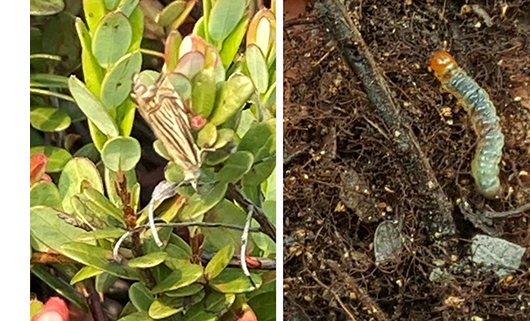
Figure 8. Cranberry girdler adult and larvae (Photo credit: Toviah Bass and Dan Schiffhauer).
Cranberry Rootworm
Rhabdopterus picipes Olivier (Coleoptera: Chrysomelidae)
No known threshold
Description
Cranberry rootworm is not always of concern in cranberries in New Jersey but has the potential to cause severe damage in the bogs. This insect has one generation a year. Mature larvae overwinter deep in the soil in the cranberry bogs. Normally in New Jersey, pupation occurs in late May. Adults emerge during early June and remain active throughout July; they are nocturnal and hide in leaf litter and are around 5 mm (0.2 inch) long, with dark-brown, bronzed, and shiny coloration (Figure 9). Eggs are laid in July on the soil surface. After hatching, the young larvae start to feed on the roots, which lasts until October. The larvae are about 8 mm (0.3 inch) long, cream in color with a light brown head, and usually assume a curved position (Figure 9). In the fall and winter, mature larvae move down in the soil to overwinter.
Damage
Feeding damage is often severe in limited areas, causing brown spots in the bog. Although the adults may feed on small berries, most of the damage is caused by the larvae. Larvae live in the soil, where they feed on the cranberry roots.
Sampling and Control
Currently, there is no action threshold for this insect, but other root feeding chrysomelid beetles (i.e., red-headed flea beetle in Wisconsin) have suggested action thresholds of 10–20 beetles per 25 sweeps. Adults can be easily picked up in a sweep net. Cultural controls for cranberry rootworm include holding of the water to delay onset of pupation. Entomopathogenic nematodes (Heterorhabditis bacteriophora) can be used to control cranberry rootworm. Neonicotinoid insecticides, which work best on early-instar larvae, can also be used. These insecticides should be applied post bloom because they are toxic to bees and other pollinators.
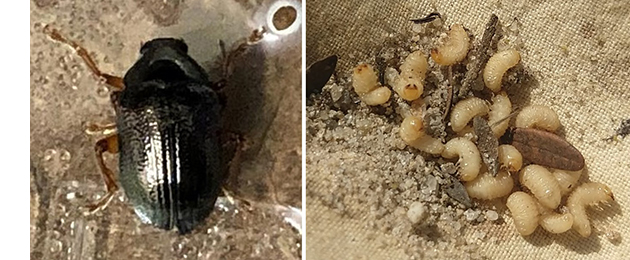
Figure 9. Cranberry rootworm adult and larvae.
White Grubs
Phyllophaga spp. (Coleoptera: Scarabaeidae)
No known threshold
Description
White grubs are the most common scarab beetles in cranberries in New Jersey. There are several species of white grubs (including Phyllophaga georgiana and Phyllophaga anxia) that infest cranberries and have similar lifestyles. White grubs can feed on many hosts and only the larvae are cranberry pests. Although their life cycle in cranberries is not well known, these grubs can have a 3-year life cycle. They can overwinter as either a larva or an adult. Eggs are laid mostly in June. The second instars burrow into the soil to overwinter. In the following year, second instars migrate upwards and feed until late July, then they molt to a third instar (Figure 10). After feeding for a period, third instars burrow into the soil to overwinter. The third instars do little feeding in the following spring and pupate in July. Newly formed beetles appear in the soil in August through early September, remain in the soil, and overwinter. Finally, adults emerge from the ground in May–June the following year. White grubs are C-shaped and over 35 mm (1.4 inch) long when fully grown (Figure 10). The adults are reddish brown (Figure 10) and nocturnal.
Damage
The larvae tend to feed gregariously on roots. Additionally, the larvae can move a lot and damage more vines than possibly expected (Figure 10). Only the larval stage is considered a pest in cranberries, and adult beetles do not feed on foliage.
Sampling and Control
There is no current action threshold for white grubs in cranberries. There exist pheromone lures for white grubs, although there are potentially many different Phyllophaga species that do not necessarily respond to the same pheromones. Larvae can be easily seen when peeling back dead or dying cranberry plants, especially near the edges of the bog. Entomopathogenic nematodes, like Steinernema scarabaei, have been shown to control P. georgiana. Neonicotinoids are systemic insecticides effective against early-instar white grubs. Applications of neonicotinoid insecticides need to occur multiple years in a row due to the white grubs 3-year life span. These applications should always occur post bloom because neonicotinoids are toxic to bees and other pollinators.
Figure 10. Developmental stages of Phyllophaga georgiana and damage to cranberries (Photo credit: Robert Holdcraft).
September 2023
Copyright © 2025 Rutgers, The State University of New Jersey. All rights reserved.
For more information: njaes.rutgers.edu.
Cooperating Agencies: Rutgers, The State University of New Jersey, U.S. Department of Agriculture, and Boards of County Commissioners. Rutgers Cooperative Extension, a unit of the Rutgers New Jersey Agricultural Experiment Station, is an equal opportunity program provider and employer.

